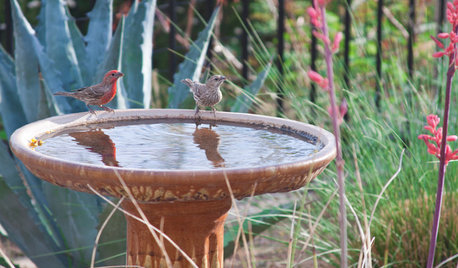Blackberry--Apache
birdsnblooms
13 years ago
Related Stories

GARDENING GUIDESMake Your Garden a Haven for Backyard Birds
Create a bird-friendly habitat in your yard with food, water and shelter
Full StoryHello.. I hope someone can help. Yesterday, Fri/6/25/10,I received a Blackberry, 'Apache.'
Even after Googling, I'm still confused. LOL
Some sites say Apache is hardy to zone 5, others say zone 6.
I'm in central IL, zone 5. Anyone know if Apache will survive our harsh winters?
Since I've never grown any type of edible berry before, outdoors, any info will help.
One important question, is Apache a bush or vine? I need this information in case Apache a trellis is required.
What about pH. The phamplet that came with the berry said it needs acidic soil- 5.0-5.5..Some sites Googled said, it needs Alk/6.5-7.0 pH. Very confusing.
How deep should it be planted? Does it need a male and female plant to fruit?
Is there any other info I should know..I actually bought two blackberry plants. They arrived bare-root, the tallest branch about 2' tall.
Both plants are in a bucket of water. I was hoping someone had answers. I appreciate your time and help..Thanks, Toni


franktank232
birdsnbloomsOriginal Author
Related Professionals
Deer Park Landscape Architects & Landscape Designers · East Rancho Dominguez Landscape Architects & Landscape Designers · Fillmore Landscape Architects & Landscape Designers · Franconia Landscape Architects & Landscape Designers · Wilmington Landscape Contractors · Choctaw Landscape Contractors · Fort Hunt Landscape Contractors · Holland Landscape Contractors · Kaysville Landscape Contractors · Lynwood Landscape Contractors · Petaluma Landscape Contractors · St. Louis Landscape Contractors · Twin Falls Landscape Contractors · Wareham Landscape Contractors · San Pablo Landscape Contractorsbrookw_gw
oregonwoodsmoke
olpea
franktank232
gtippitt
olpea
birdsnbloomsOriginal Author
wally_1936
larry_gene
gtippitt
strudeldog_gw
strudeldog_gw
gtippitt
ksgrower
franktank232